
The Salar Jung Museum is an art museum located at Dar-ul-Shifa, on the southern bank of the Musi River in the city of Hyderabad, Telangana, India. It is one of the notable National Museums of India. Originally a private art collection of the Salar Jung family, it was endowed to the nation after the death of Salar Jung III. It was inaugurated on 16 December 1951.

The National Gallery of Modern Art (NGMA) is the premier art gallery under Ministry of Culture, Government of India. The main museum at Jaipur House in New Delhi was established on 29 March 1954 by the Government of India, with subsequent branches at Mumbai and Bangalore. Its collection of more than 1700 works by 2000 plus artists includes artists such as Thomas Daniell, Raja Ravi Verma, Abanindranath Tagore, Rabindranath Tagore, Gaganendranath Tagore, Nandalal Bose, Jamini Roy, Amrita Sher-Gil as well as foreign artists. Some of the oldest works preserved here date back to 1857. With 12,000 square meters of exhibition space, the Delhi branch is one of the world's largest modern art museums.

The Bengal School of Art, commonly referred as Bengal School, was an art movement and a style of Indian painting that originated in Bengal, primarily Kolkata and Shantiniketan, and flourished throughout the Indian subcontinent, during the British Raj in the early 20th century. Also known as 'Indian style of painting' in its early days, it was associated with Indian nationalism (swadeshi) and led by Abanindranath Tagore (1871–1951), but was also being promoted and supported by British arts administrators like E. B. Havell, the principal of the Government College of Art and Craft, Kolkata from 1896; eventually it led to the development of the modern Indian painting.

Indian painting has a very long tradition and history in Indian art, though because of the climatic conditions very few early examples survive. The earliest Indian paintings were the rock paintings of prehistoric times, such as the petroglyphs found in places like the Bhimbetka rock shelters. Some of the Stone Age rock paintings found among the Bhimbetka rock shelters are approximately 10,000 years old.

Amrita Sher-Gil was a Hungarian-Indian painter. She has been called "one of the greatest avant-garde women artists of the early 20th century" and a pioneer in modern Indian art. Drawn to painting from an early age, Sher-Gil started formal lessons at the age of eight. She first gained recognition at the age of 19, for her oil painting Young Girls (1932). Sher-Gil depicted everyday life of the people in her paintings.
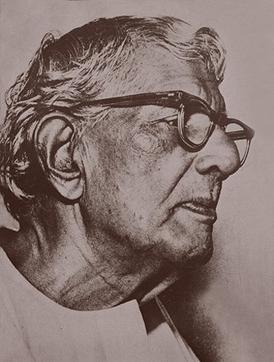
Jamini Roy was an Indian painter. He was honoured by the Government of India the award of Padma Bhushan in 1954. He remains one of the most famous pupils of Abanindranath Tagore, another praised Indian artist and instructor.

Nandalal Bose was one of the pioneers of modern Indian art and a key figure of Contextual Modernism.
Paresh Maity is an Indian painter. He is a prolific painter in a short career span.

Ramkinkar Baij was an Indian sculptor and painter, one of the pioneers of modern Indian sculpture and a key figure of Contextual Modernism.

Mukul Chandra Dey was one of five children of Purnashashi Devi and Kula Chandra Dey. He was a student of Rabindranath Tagore's Santiniketan and is considered as a pioneer of drypoint-etching in India. The entire family of Mukul Dey had artistic talents, the brother Manishi Dey was a well-known painter, and his two sisters, Annapura and Rani Chanda, were accomplished in arts and crafts as well.
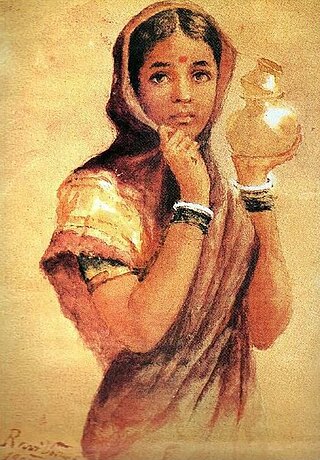
Sree Chitra Art Gallery is an art gallery in Thiruvananthapuram, India, established in 1935. It is located in the northern grounds of the Napier Museum. It was inaugurated by Chithira Thirunal Balarama Varma. The gallery features a unique collection of traditional and contemporary paintings, including the works of Raja Ravi Varma, Nicholas Roerich, Svetoslav Roerich, Jamini Roy, Rabindranath Tagore, V. S. Valiathan, C. Raja Raja Varma, and K. C. S. Paniker. There are approximately 1100 paintings at the gallery.
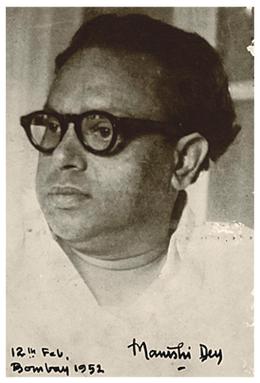
Manishi Dey was an Indian painter of the Bengal School of Art. Manishi Dey was the younger brother of Mukul Dey, a pioneering Indian artist and dry point etcher. Their two sisters, Annapura and Rani, were accomplished in arts and crafts as well.

The modern Indian art movement in Indian painting is considered to have begun in Calcutta in the late nineteenth century. The old traditions of painting had more or less died out in Bengal and new schools of art were started by the British. Initially, protagonists of Indian art such as Raja Ravi Varma drew on Western traditions and techniques including oil paint and easel painting. A reaction to the Western influence led to a revival in primitivism, called as the Bengal school of art, which drew from the rich cultural heritage of India. It was succeeded by the Santiniketan school, led by Rabindranath Tagore's harking back to idyllic rural folk and rural life. Despite its country-wide influence in the early years, the importance of the school declined by the 'forties' and now it is as good as dead.

Raman Siva Kumar, known as R. Siva Kumar, is an Indian contemporary art historian, art critic, and curator. His major research has been in the area of early Indian modernism with special focus on the Santiniketan School. He has written several important books, lectured widely on modern Indian art and contributed articles to prestigious international projects such as the Art Journal, Grove Art Online or The Dictionary of Art, Oxford University Press.
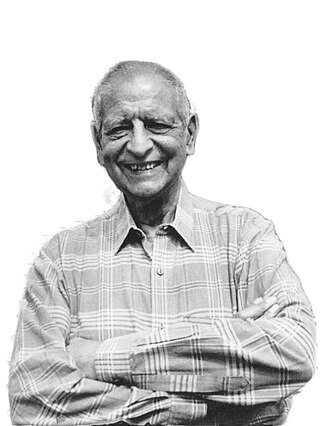
Kekoo Gandhy was an Indian art gallerist, art collector and art connoisseur, who pioneered the promotion of Indian modern art from the 1940s. He established Chemould Frames, a frame manufacturing business in 1941, soon he started displaying works of young modern artists K. H. Ara, S. H. Raza, K. K. Hebbar and M. F. Husain in his showroom windows. This led to gradual rise of modern art movement and post-colonial art in India. Eventually Gallery Chemould, India's first commercial art gallery, was opened in 1963 on the first floor of the Jehangir Art Gallery.
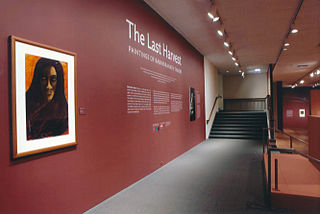
The Last Harvest was an exhibition of Rabindranath Tagore's paintings to mark the 150th anniversary of Tagore's birth. It was commissioned by the Ministry of Culture, India and organised with the National Gallery of Modern Art (NGMA). It consisted of 208 paintings drawn from the collections of Visva Bharati and the NGMA. The exhibition was curated by art historian R. Siva Kumar. Asia Art Archive later classified the exhibition as a "world event".

Balan Nambiar is an Indian painter, sculptor, enamellist, photographer and an academic researcher.
Sadhu Aliyur was an Indian (watercolor) painter and art teacher from Kerala, India. He has done a workshop on the art of watercolor painting at the State Gallery of Fine Arts. He co-founded "Colouring India foundation" a non profit organisation.
The Museum of Art and Photography (MAP) is a private art museum based in Bangalore, India that is a custodian to a collection of Indian art, textiles, photography, craft, and design objects spanning from the twelfth century to the present.


















